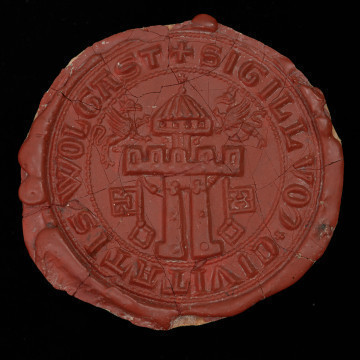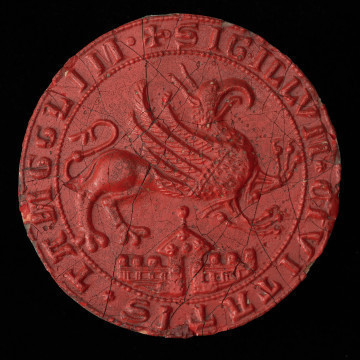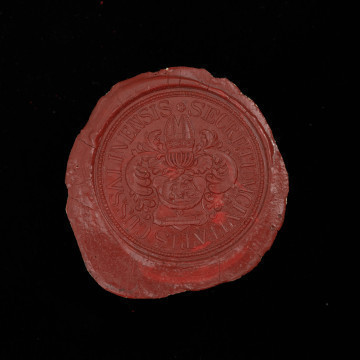
Impression of the municipal seal of Greifswald
1295
National Museum in Szczecin
Part of the collection: Seals of Pomeranian cities
The settlement of Garz on the island of Rügen became a city by the decree of the Prince of Rügen, Vitslav III (1265/8-1325) in 1316 or 1317. Garz was one of the few Pomeranian cities to adopt the motif of the city wall as the main element of its coat of arms. A wax imprint of the city seal, which dates back to the first half of the 14th century shows a city wall with two towers, along with a gate. Behind the wall, one can see the keep – a defensive residential tower equipped with one elongated and two tracery window openings. The coat of arms also features the banner of Prince Vitslaw III placed on the top of the keep, with an image of a griffin rampant, which over time became an official sign of the members of the Griffin dynasty. The griffin, often appearing as the main motif of the municipal coat of arms, here constitutes only an additional element. Garz was an old settlement. Despite the destruction of the gord by the Danes in 1168, it continued to be an administrative centre for the local rulers; however, for many years the settlement was considered rural. This makes it obvious why granting it the city privileges was considered an important event – so much so that the main element of the coat of arms featured a symbol of the city's sovereignty, the city wall, rather than the sign of the founder. Like many coats of arms of Pomeranian cities, the coat of arms of Garz underwent major changes. The seal, which probably dates back to the early 17th century, features a banner without a griffin, and the letter G appears in the gate – introduced to the design by the German graphic artist and herald Otto Hupp (1859-1949). Hupp also made changes in other elements of the coat of arms, changing the keep and proposing a straight wall, instead of an arched one. The current coat of arms of Garz does not Hupp’s suggestions – instead, it closely resembles the city seal from the first half of the 14th century.
Mieszko Pawłowski
Other names
Siegel
Author / creator
Dimensions
cały obiekt:
Object type
seal
Technique
impressing
Material
wax
Creation time / dating
Creation / finding place
Owner
National Museum in Szczecin
Identification number
Location / status

1295
National Museum in Szczecin

1284
National Museum in Szczecin

1. połowa XIX wieku
National Museum in Szczecin
DISCOVER this TOPIC
Museum of King Jan III's Palace at Wilanów
DISCOVER this PATH
Educational path